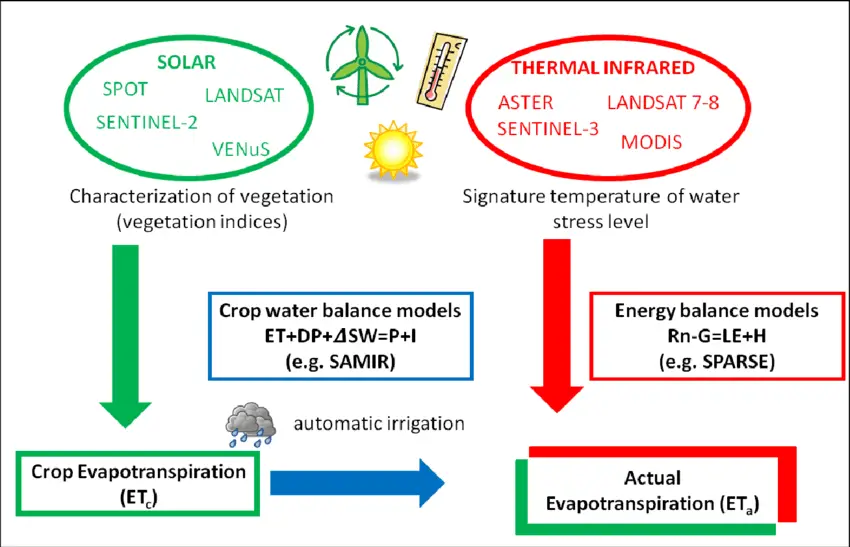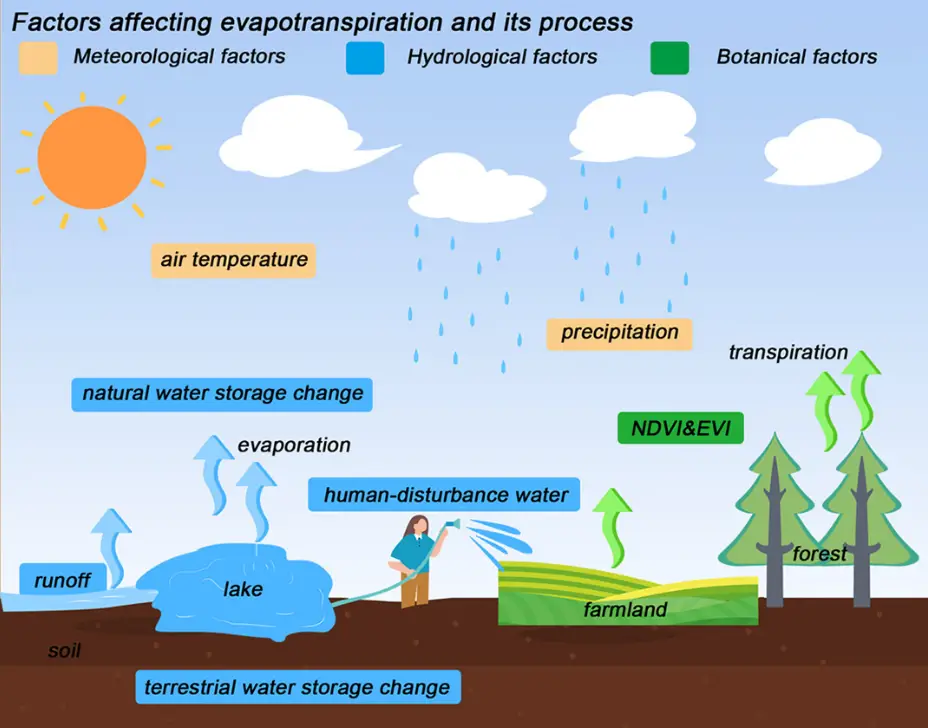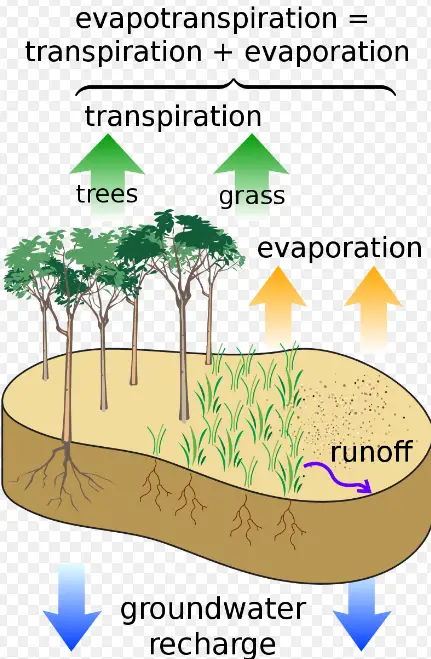Evapotranspiration is a fundamental concept in hydrology and environmental science, crucial for understanding how water cycles through ecosystems from the ground to the atmosphere. This process combines two key phenomena: evaporation, the transformation of water from liquid to gas from soil and water bodies, and transpiration, where plants release water vapor during photosynthesis. Both are essential for climate regulation, agricultural planning, and water resource management.
Actual evapotranspiration and potential evapotranspiration are two distinct types of this process. Actual evapotranspiration is the quantity of water actually transpired by plants and evaporated from a surface area, typically influenced by the availability of moisture and prevailing weather conditions. In contrast, potential evapotranspiration represents the maximum amount of water that could be evaporated and transpired if there were sufficient water available, largely driven by climatic factors like temperature and solar radiation.
Understanding the difference between actual and potential evapotranspiration is key to effective water management strategies, especially in areas prone to drought or excessive rainfall. It informs everything from agricultural practices to water conservation efforts and plays a vital role in predicting agricultural productivity and managing ecological health.

Basic Concepts
What is Evapotranspiration?
Evapotranspiration is a hybrid process combining evaporation and transpiration. It plays a crucial role in the water cycle, influencing local and global climates. The process involves the transfer of water from the earth’s surface and plant leaves into the atmosphere. During evaporation, water changes from liquid to vapor from open bodies of water, soil, and other surfaces. Transpiration occurs when plants release water vapor through their leaves, a vital part of their respiratory process.
Types of Evapotranspiration
Evapotranspiration varies depending on environmental conditions and water availability, leading to different types:
- Open Water Evaporation: Water loss solely from bodies of water.
- Transpiration: Specific to water vapor released by plants.
- Soil Evaporation: Involves water vaporizing directly from the soil.
- Interception Loss: Water evaporated from plant surfaces before it hits the ground.
Actual Evapotranspiration
Defining Actual Evapotranspiration
Actual evapotranspiration is the measure of water actually transferred from the land to the atmosphere. It reflects real-world conditions, accounting for the water available and the environmental influences at any given time.
Factors Influencing Actual Rates
Several factors impact the rate of actual evapotranspiration:
- Climate: Temperature, sunlight, and wind speed are critical.
- Soil Moisture Levels: Availability of water in the soil determines how much can evaporate or be used by plants.
- Vegetation Type: Different plants transpire at different rates.
- Seasonal Changes: Weather patterns influence water availability and demand.
Measuring Actual Evapotranspiration
Accurately gauging this process is challenging but essential for effective water management.
Tools and Methods
- Lysimeters: Devices that measure the amount of water consumed in evapotranspiration.
- Remote Sensing Techniques: Satellite imagery to assess vegetation health and moisture levels.
- Water Balance Approach: Estimates based on rainfall, runoff, and soil moisture data.
Challenges in Measurement
- Spatial Variability: Changes in landscape and vegetation make uniform measurements difficult.
- Data Limitations: Inadequate weather data can lead to inaccurate estimations.
- Technological Constraints: High costs and complexity of advanced instruments.
Potential Evapotranspiration
Defining Potential Evapotranspiration
Potential evapotranspiration is an estimate of the maximum amount of evapotranspiration that could occur given unlimited water resources. This concept is crucial in understanding the maximum water demand of an area under current climatic conditions.
Theoretical Aspects
It is based on several assumptions:
- Sufficient Water: Assumes no limitation in water supply.
- Standard Conditions: Based on average climatic data, not real-time.
Calculating Potential Evapotranspiration
Estimating potential evapotranspiration involves complex models that consider various climatic factors.
Common Models and Equations
- Penman-Monteith Equation: Widely accepted for its accuracy, incorporating solar radiation, temperature, humidity, and wind speed.
- Thornthwaite Method: Simpler, using temperature data to estimate monthly evapotranspiration.
Factors Considered in Calculations
- Climate Data: Temperature, solar radiation, and wind are essential inputs.
- Geographic Location: Latitude and elevation affect solar exposure and air density.
- Time of Year: Seasonal variations influence the potential rates

Comparing Both Types
Key Differences
Understanding the distinctions between actual and potential evapotranspiration is pivotal for various scientific and practical applications. Although they share foundational principles, their implications in real-world scenarios differ significantly.
Comparison of Definitions
- Actual Evapotranspiration: Represents the actual amount of water that is transpired from plants and evaporated from surfaces under existing environmental conditions. It is directly affected by the availability of water.
- Potential Evapotranspiration: The theoretical maximum amount of evapotranspiration that would occur if there were unlimited water resources available. It primarily depends on climatic factors like temperature and humidity.
Differences in Measurement and Calculation
- Measurement Techniques: Actual evapotranspiration is measured using lysimeters and remote sensing technology that directly observes current conditions. In contrast, potential evapotranspiration is often calculated using climatic data models.
- Calculation Models: Different models are employed depending on the focus. For actual evapotranspiration, the water balance approach is commonly used, while potential evapotranspiration calculations rely on formulas like the Penman-Monteith equation, which considers climatic variables assumed to be optimal for evaporation.
Environmental Implications
Impact on Water Resource Management
Both types of evapotranspiration play critical roles in managing water resources. Understanding these can significantly enhance water conservation strategies and irrigation practices.
- Efficiency in Water Use: Knowledge of actual evapotranspiration helps in applying precise amounts of water needed for agriculture, reducing waste. Potential evapotranspiration data is used to forecast water needs for different regions, helping in the allocation and regulation of water resources.
- Drought Management: Accurate measurements of actual evapotranspiration can provide early warning signs of drought conditions, allowing for timely interventions. On the other hand, potential evapotranspiration estimates are crucial in long-term drought risk assessments and planning.
Role in Climate Modeling
Evapotranspiration is a major factor in climate dynamics, influencing local and global weather patterns.
- Regulation of Local Climates: Evapotranspiration processes contribute to cooling effects in agricultural regions and forests, impacting local weather conditions.
- Global Water Cycles: Both actual and potential evapotranspiration are integrated into global climate models, helping predict changes in precipitation patterns and temperature due to various climate change scenarios.
Case Studies
Real-World Examples
Investigating how actual and potential evapotranspiration are applied in various fields can highlight their importance and versatility in real-world applications.
Application in Agriculture
Farmers and agronomists use evapotranspiration data to make informed decisions about irrigation scheduling and crop selection.
- Irrigation Scheduling: By understanding the actual evapotranspiration rates, farmers can optimize their watering schedules to match the crop’s water requirements with environmental conditions.
- Crop Selection: Different crops have varying water demands. Potential evapotranspiration data helps in selecting appropriate crops for specific climates, maximizing yield while conserving water.
Use in Hydrological Models
Hydrologists incorporate both actual and potential evapotranspiration in their models to simulate water flows and storages in watersheds and catchment areas.
- Flood Prediction: Models that accurately account for evapotranspiration can predict runoff levels and potential flooding events, aiding in disaster preparedness.
- Water Storage: Understanding evapotranspiration dynamics helps in the design of reservoirs and other water conservation systems, ensuring they are capable of meeting the water demands during dry periods.
Frequently Asked Questions
What is evapotranspiration?
Evapotranspiration is the process by which water is transferred from the land to the atmosphere by evaporation from the soil and other surfaces and by transpiration from plants. This combined process is critical for maintaining moisture balance in various ecosystems and is a key component of the water cycle.
How do actual and potential evapotranspiration differ?
Actual evapotranspiration refers to the actual amount of water evaporated and transpired by a specific area under existing conditions of soil moisture and weather. Potential evapotranspiration, however, is the amount of evaporation and transpiration that would occur if there was an unlimited water supply, determined primarily by the climate.
Why is understanding evapotranspiration important?
Understanding evapotranspiration is essential for effective water management, agricultural planning, and ecological conservation. It helps predict water needs, assess drought conditions, and manage irrigation systems more efficiently, contributing to sustainable water resources management.
How is potential evapotranspiration calculated?
Potential evapotranspiration is calculated using various climatic factors, including temperature, humidity, solar radiation, and wind speed. Models like the Penman-Monteith equation are commonly used to estimate these values accurately, providing essential data for environmental and agricultural studies.
Conclusion
In conclusion, the distinction between actual and potential evapotranspiration is a cornerstone of environmental science, pivotal in managing water resources effectively. Recognizing how each type influences ecosystem dynamics and water availability helps in crafting strategies that enhance water sustainability and agricultural productivity. As challenges like climate change intensify, the relevance of accurate evapotranspiration data becomes even more critical in safeguarding natural resources and supporting global food security.
Understanding these processes in depth not only aids in environmental conservation efforts but also enables policymakers and scientists to devise better strategies for managing the earth’s water cycles. This knowledge is indispensable in adapting to the changing climate and ensuring a stable future for water resources worldwide.

